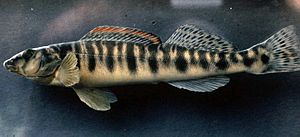Conasauga logperch facts for kids
Quick facts for kids Conasauga logperch |
|
|---|---|
 |
|
| Conservation status | |
| Scientific classification |
The Conasauga logperch (Percina jenkinsi) is a special type of fish found only in freshwater. It's a darter, which is a small fish from the same family as perches. This fish is endemic to the United States, meaning it lives naturally only in one specific area there. It's one of 184 different kinds of darters in North America. Sadly, the Conasauga logperch has been listed as an endangered species since 1985, which means it's at high risk of disappearing forever.
Contents
What Does It Look Like?
This fish is quite slender, meaning it's thin and long. It can grow up to about 4.6 inches, which is less than 5 inches long! One of its most interesting features is its nose, which looks a bit like a pig's snout. This special snout helps it find food. The Conasauga logperch also has a cool "tiger-stripe" pattern. It has many dark, vertical stripes on a yellowish body. Unlike some other fish, the male and female logperches look very similar in color.
Where Does It Live?
The Conasauga logperch is only found in a small part of the Conasauga River. This river is in northern Georgia and south-central Tennessee. It lives in an 11-mile stretch of the river. This area goes from a place called Half-way Branch in Polk County, Tennessee, all the way downstream to the Georgia State Highway 2 bridge in Murray County, Georgia. Scientists believe this fish might have come from a nearby river system a long time ago.
How It Lives and Eats
Logperches eat many different kinds of small water creatures, called invertebrates. They use their special snout to flip over rocks and stones in the river. This helps them find hidden food like tiny insect larvae (like midges, mayflies, and caddisflies), small beetles, and even other fish eggs. Young logperches eat even tinier creatures called microcrustaceans.
Bigger fish like rainbow trout and brown trout are likely the main predators of the Conasauga logperch.
These fish usually become old enough to have babies after one year. They lay their eggs in the spring in fast-moving parts of the river where there's gravel. The eggs are sticky and heavier than water, so they stick to the riverbed and don't float away. This helps keep them safe. Sometimes, other male fish might eat eggs that aren't buried well. It takes about 200 hours for the eggs to hatch.
Male logperches don't claim a specific area as their own. Several males might follow a female until she lays her eggs. The number of eggs a female lays can vary a lot, from around 130 to 3,000 eggs per year, depending on the specific type of darter. Conasauga logperches can live for at least four years.
How It Got Its Name
The Conasauga logperch was officially named in 1985 by an American scientist named Dr. Bruce A. Thompson. He studied fish, and the fish's scientific name, jenkinsi, was given to honor his friend and fellow fish scientist, Robert E. Jenkins.
Protecting the Conasauga Logperch
Because the Conasauga logperch is endangered, many people are working hard to protect it. It was officially listed as an endangered species in 1986, and a plan was made to help it recover.
One group, Conservation Fisheries, Inc. (CFI) in Knoxville, Tennessee, is trying to keep this rare fish alive. They have a few Conasauga logperches in captivity, which are the only ones known to exist outside the river. Their goal is to raise these fish so they can be released back into the Conasauga River once the river is clean and healthy enough for them.
Other organizations, like the Tennessee Aquarium and government wildlife agencies, are also helping. The Southeastern Fishes Council even put the Conasauga logperch on a list called the "Desperate Dozen," which includes the twelve fish most likely to become extinct soon.
Current efforts to save the fish include:
- Protecting the fish that still live in the Conasauga River and their homes.
- Using laws like the Federal Endangered Species Act to help keep the water clean and prevent changes to the river.
- Studying the fish's life, including how it reproduces, what it eats, how fast it grows, and what causes it to die.
- Figuring out how many fish are needed to keep the population healthy.
- Looking for new places where the fish could live or be reintroduced.
Many groups are working together to help the Conasauga logperch. These include the Forest Service, the Conasauga River Alliance (which is a group of local people, businesses, and conservation groups), the U.S. Fish and Wildlife Service, universities, and local governments. Everyone is working to make sure this unique fish has a future.
See also
 In Spanish: Percina jenkinsi para niños
In Spanish: Percina jenkinsi para niños


